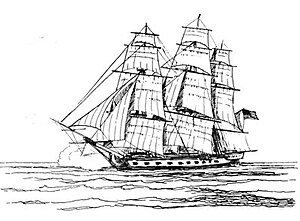USS Randolph (1776)
 |
|
| History | |
|---|---|
| Name: | USS Randolph |
| Namesake: | Peyton Randolph |
| Ordered: | 13 December 1775 |
| Builder: | Wharton and Humphreys |
| Launched: | 10 July 1776 |
| Fate: | Sunk by explosion, 7 March 1778 (311 killed/4 survived) |
| General characteristics | |
| Type: | Frigate |
| Length: | 132 ft 9 in (40.46 m) |
| Beam: | 34 ft 6 in (10.52 m) |
| Draft: | 18 ft (5.5 m) |
| Depth: | 10 ft 6 in (3.20 m) |
| Complement: | 315 |
| Armament: | 26 x 12 pdrs; 10 x 6 pdrs |
| Service record | |
| Commanders: | Capt. Nicholas Biddle |
| Operations: | |
The first USS Randolph was a 32-gun frigate in the Continental Navy named for Peyton Randolph.
Construction of the first Randolph was authorized by the Continental Congress on 13 December 1775. The frigate, designed by Joshua Humphreys, was launched on 10 July 1776, by Wharton and Humphreys at Philadelphia, Pennsylvania. Captain Nicholas Biddle was appointed commander of the Randolph on 11 July, and he took charge of the frigate in mid-October.
Seamen were scarce and recruiting was slow, delaying the ship's maiden voyage. Captured British seamen were "dragged" from jail in Philadelphia; the resulting riot required the soldiers appointed to carry the men to the ship to fire into the prison windows. Finally manned, Randolph sailed down the Delaware River on 3 February 1777, and three days later rounded Cape Henlopen, escorting a large group of American merchantmen to sea. On the 15th, the convoy separated, with some of Randolph's charges heading for France and the rest setting course for the West Indies.
The frigate herself turned northward, hoping to encounter HMS Milford, a British frigate which had been capturing New England shipping. Before long, she boarded a ship which proved to be French and was set free. Then, as she continued the search, Randolph sprung her foremast. While the crew labored to rig a spar as a jury mast, the ship's mainmast broke and toppled into the sea.
Continuing the hunt was out of the question. Now seeking to avoid the Royal Navy's warships, Biddle ordered the ship south toward the Carolina coast.
Fever broke out as the Randolph painfully made her way, and many members of the crew were buried at sea. A mutiny of the captured British seamen had to be put down before the ship could reach Charleston, South Carolina, on the afternoon of 11 March.
...
Wikipedia
